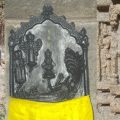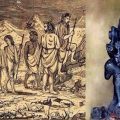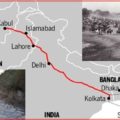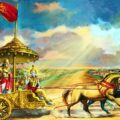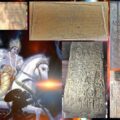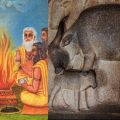Horses Indigenous to India; Here Are Archaeological, Literary Evidences
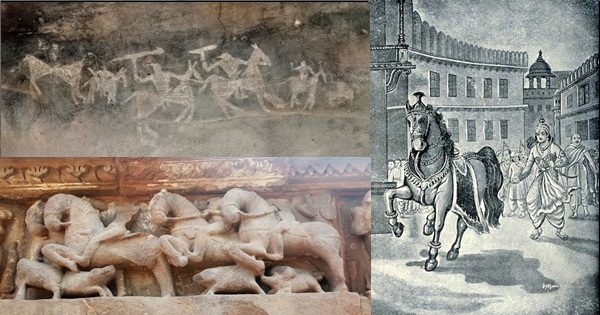
Are horses indigenous to India? It is a big ‘Yes’! There are both archaeological and literary evidences that suggest they are native to India. The Vedas find mention of aswa (horse) over 200 times. Chariots also find mention in the Vedas. Usha (dawn) and Agni are depicted riding chariots driven by horses. Samudra Manthana, the churning of the ocean, which finds mention in the Vishnu Purana, Bhagavata Purana, and Mahabharata tell us about Uchhaishravas, the divine seven-headed horse. Uchhaishravas, considered the king and the best of horses, emerged from the churning. According to the book Chronology of India by Shri Vedveer Arya, the Vedic era dates back to at least 15000 BCE.
The Ramayana and Mahabharata are historical events, not myths. There are several instances in the Ramayana that depict horses and chariots. For example, Kaikeyi maintained strong relations with her maternal family even after her wedding with Raja Dasharath. Her brother Yudhajit visited her quite often and he regularly took his nephew Bharata and also Shatrughna, the step son of Kaikeyi to the Kaikeya kingdom for vacation. They rode on horses and also rode on horse-driven chariots.
Kaikeyi was Dasharath’s charioteer in his military campaign against Sambarasura. During the battle, Dasharath’s chariot broke and Sambarasura’s arrow pierced the king’s armor and lodged in his chest. At this juncture, it was Kaikeyi’s presence of mind, bravery, and wit that saved Dasharath’s life. She quickly repaired the broken wheel and drove the chariot away from the battlefield. In the Mahabharata war, major part of the Kauravas and Pandavas rode on horse-driven chariots. The Mahabharata also describes and finds mention of Ashwamedha yajna, pertaining to the horse.
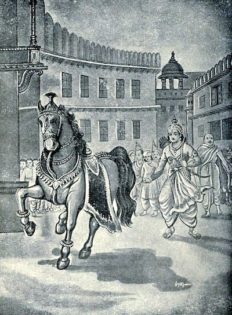
Ashwamedha horse – Mahabharata; Image (also used as part of featured image) source: Pinterest (pin/475692779368900748/)
The term ‘Aswa’ or ‘Ashwa’ mentioned in the Vedas and other Hindu scriptures has been misinterpreted to mean sacrifice, which is completely wrong. To quote Vivek Arya, “Ashwa according to the Shatapatha Brahmana (XIII.3.3) means God. Taking hold of this meaning we can without the least hesitation say that Ashwamedha has spiritual significance. Ashwa means horse as well as all such physical forces which can enable us to move quickly. In another place we read Ashwa, the Agni (heat) carries, like the animals of conveyance, the learned who recognize its distance-carrying properties (Rig Veda 1.27-1). This idea is also supported by Shatapatha (III.3.29-30).”
A fake narrative has been doing the rounds in social media, print platforms, academic papers, and intellectual circles that horses are not indigenous to India, that they were brought by the Aryans to India in around 1500 BCE. Through this myth, the fake Aryan Invasion Theory and later Aryan Migration narrative have been kept alive. Many believe this to be true. Despite the recent genetic evidence (DNA analysis on 5000 year-old human skeleton in Rakhigarhi site) that prove the Aryan Invasion/Migration theory false, Scroll in a recent article published thus, “Science is proving India’s incredible diversity. But this clashes directly with ‘HINDUTVA’S RACIALLY NATIVIST’ understanding of the subcontinent”. So, the Hindutva flavor irrespective of scientific evidences, does rule the roost. Despite evidence Scroll mocks at the ancient Indian ethos and existence of Hindu Gods and still tries to prove right the proposed fake theory. The article’s featured image shows a warrior in chariot driven by horses marching towards the Indus valley from the West.
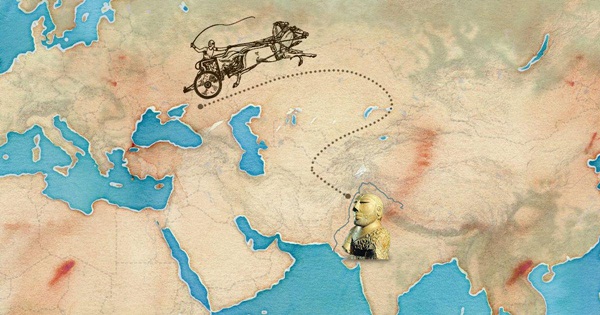
Featured image in Scroll’s article showing so called ‘Aryans’ in a chariot riding towards India!; Image courtesy: Scroll.
In the above context that horses were brought by the so called Aryans to India, Maj Gen GD Bakshi had said in a speech on his latest book Sarasvati Civilization at an event that during his several years of his stint commanding the Indian Army in the rough terrains of Kashmir, taking a tank to the top was a tough affair. To him how could so called Aryans bring horse drawn chariots believe to have galloped down the Khyber pass through the rough mountain ranges to India? That was impossible and ridiculous to be believed he had said.
Bhimbetka Caves in Madhya Pradesh have several paintings of horses dating back to several thousand years. The caves are spread across 10 kms and house 750 rockshelters. The paintings and evidences of habitation in most of these rockshelters date back from medieval period to 1 lakh years.
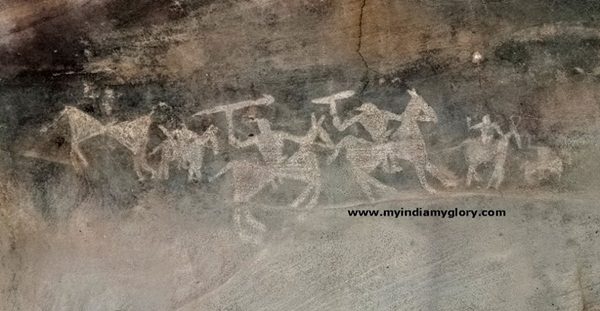
Natives riding on horses ready for battle – a painting on a rock wall at Bhimbetka caves; Image clicked by Manoshi Sinha
The rock art in most of the caves have started to fade. These paintings are very precious that prove the antiquity of our thousands of years old civilizational identity. The above painting shows a group of men ready for battle. While there have been several researches on the paintings on the rock walls, this painting dates back to at least 30,000 years. While a particular group of researchers claim that these date back to the medieval period, thus trying to prove they are only few hundred years old, the battle scene depicted points out it is pre-historic. It doesn’t not look medieval at all.
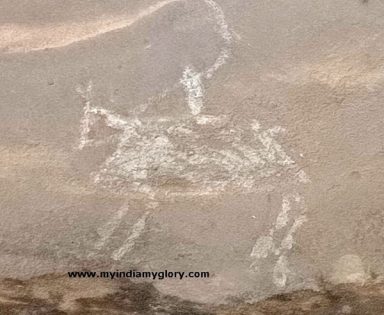
Bhimbetka cave painting of a lone native riding a horse. He is either ready for battle or for a hunt; Image clicked by Manoshi Sinha
The above painting is of another native riding a horse. He may either be ready for hunting or for battle. Our ancestors were hunters thousands of years ago. This painting has also been proven to be from the pre-historic period dating back to several thousand years.
The pattern of both the paintings of horses with riders depicted above are similar to those paintings of dancers and hunters dating back to Mesolithic era and beyond. And the Mesolithic era dates back to around 20,000 years maximum. Where does the question about outsiders (projected to be Aryans by fake theorists) introducing horses to India in 1500 BCE arise?
On Mesolithic era, there are different viewpoints with majority fixing the timeline in Asia between 20,000 years to 8,000 years ago. In the Indian context, the entire chronology of historical events, as imposed by the colonial masters without any scientific, literary, epigraphical, archaeological evidences, starts from 1500 BCE. This distorted chronology marks Vedic era from 1500 BCE. They don’t consider Ramayana and Mahabharata events as historical episodes. But according to a number of evidences spanning astronomical calculations, literary records, inscriptional/epigraphical evidences, archaeological excavation reports, and related paraphernalia, Indian chronology (continuous chronological history from Vedic period, Ramayana, Mahabharata to present) start from 15000/21000 BCE.
Archaeological evidences prove Indian civilization dates back beyond 75000 yrs (Jwalapuram excavations). According to Vedveer Arya’s books in two Volumes – The Chronology of India, the Vedic era starts around 15000 BCE. Researches of Nilesh Nilkanth Oak (author of Historic Rama: Indian Civilization, When Did the Mahabharata War Happen?) put Vedic era around 21000 BCE. Going by these calculations, the Mesolithic era, may well date beyond 20,000 years. Here is a screenshot of the general calculation of the Mesolithic period taken from a portal:
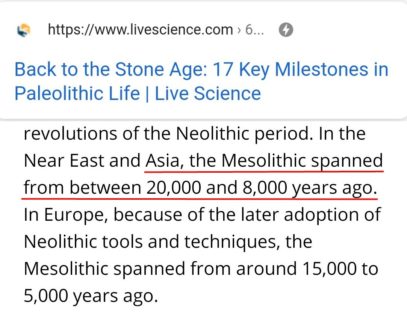
Depicted below is another painting of a horse from Bhimbetka caves. The paintings have started to fade. This painting seems to be of a later period, given the sophistication in the art style.
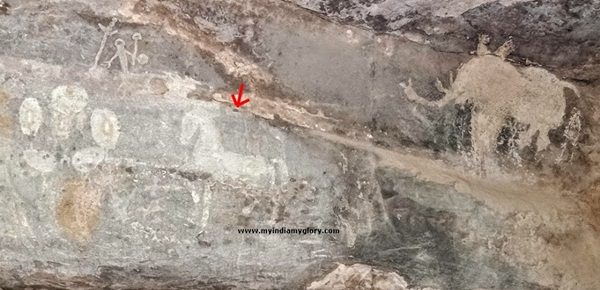
Single horse painting at Bhimbetka Caves; Image clicked by Manoshi Sinha
To quote Archaeological Survey of India’s ‘Rock Shelters of Bhimbetka: Continuity through Antiquity, Art & Environment’, UNESCO on Bhimbetka Caves, “The richness and variety of this unusually large concentration of paintings, the greatest in the world, within a site which has demonstrated a progressive sequential use through the ages remain unparalleled. Bhimbetka’s rock shelters far outnumber the largest known evidence of the prehistoric caves of Dordogne in southwest France. While evidences from Dordogne yield cultural products between 100,000 BP and 10,000 BP, very few of the caves show continued occupancy during this period. Bhimbetka is exceptional in the fact that in at least one of the excavated shelters (III F-23), continued occupation is demonstrable from 100,000 BP (Late Acheulian) to 1000 AD.”
There are various archaeological evidences of the physical presence of horses in India many many years before the much hyped fake theory that ‘horses existed in India from 1500 BCE after the Aryans came riding on them to invade the local population’. These are both skeletal remains and terracotta figurines in the ancient Indus-Saraswati river belt and beyond. How could ancient Indians create figurines of horses without a visual look, without their presence?
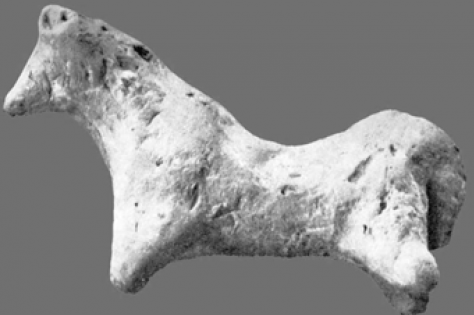
Horse-figurine-from-Lothal; Source: ‘The Horse and the Aryan Debate’ by Michel Danino
In this context, Michel Danino wrote in a paper titled ‘The Horse and the Aryan Debate’, “Our first surprise is that contrary to conventional assertions, quite a few archaeologists have reported horse remains from India’s prehistoric sites. A Ghosh’s respected and authoritative Encyclopaedia of Indian Archaeology mentions without fuss:
In India the … true horse is reported from the Neolithic levels at Kodekal [dist. Gulbarga of Karnataka] and Hallur [dist. Raichur of Karnataka] and the late Harappa levels at Mohenjo-daro (Sewell and Guha, 1931) and Ropar and at Harappa, Lothal and numerous other sites. … Recently bones of Equus caballus have also been reported from the proto-Harappa site of Malvan in Gujarat.
The well-known archaeologist B. B. Lal refers to a number of horse teeth and bones reported from Kalibangan, Ropar, Malvan and Lothal. Another senior archaeologist, S. P. Gupta, adds further details on those finds, including early ones. In the case of Lothal, the archaeozoologist Bhola Nath certified the identification of a tooth; he also made similar observations regarding bones from Mohenjo-daro and Harappa.”
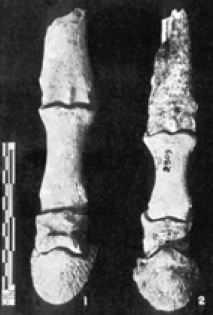
Horse bones from Surkotada in Katchchh; Source: ‘The Horse and the Aryan Debate’ by Michel Danino
To quote Michel Danino further from the paper, “…we have the case of Mahagara (near Allahabad), where horse bones were not only identified by G. R. Sharma et al., but ‘six sample absolute carbon 14 tests have given dates ranging from 2265 B.C.E. to 1480 B.C.E.’ The case of Hallur, mentioned by A. Ghosh above, is even more striking: the excavation (in the late 1960s) brought out horse remains that were dated between 1500 and 1300 BCE, in other words, about the time Aryans are pictured to have galloped down the Khyber pass, some 2,000 north of Hallur. Even at a fierce Aryan pace, the animal could hardly have reached Karnataka by that time.”
“When K. R. Alur, an archaeozoologist as well as a veterinarian, published his report on the animal remains from the site, he received anxious queries, even protests: there had to be some error regarding those horse bones. A fresh excavation was eventually undertaken some twenty years later — which brought to light more horse bones, and more consternation.”
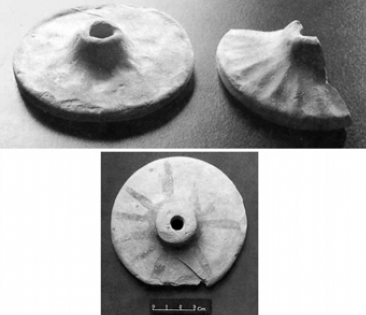
Terracotta wheels from Banawali and Rakhigarhi displaying spokes painted or in relief; Source: ‘The Horse and the Aryan Debate’ by Michel Danino
Few more archaeological proofs of the physical presence of horses in ancient India:
1. Terracotta figurines dating back to Chalcolithic and early historic period were found at the excavated site of Ahar near Udaipur in Rajasthan. The Chalcolithic period, also called Copper Age, dates back from 3500 to 2300 BCE and beyond.
2. Excavations at Noh, located around 6.43km west of Bharatpur in Rajasthan led to discovery of figurine of horse from the Shunga or Kushana period. According to the book Chronology of India by Vedveer Arya, the Shungas flourished more than 3200 years ago.
3. At the excavated site of Rairh in Rajasthan, terracotta figurines of horses, dating back to Maurya and post Maurya period have been found. According to the book Chronology of India by Vedveer Arya, the Mauryas flourished during 16th century BCE. Few horse figurines are depicted with riders.
In March 2018, a 10-member team of Institute of Archaeology with Arvin Manjul as Co-Director conducted research at the excavation site of Sanauli in UP. They found a chariot with solid wheel and pole from the Bronze Age, dating back to at least 4500 years, in a pit. The team also found a crown or helmet worn by the rider of the chariot. According to Manjul, as reported by news18.com, the animal used to run it “preliminary understanding points at the horse.” According to the same news report, Manjul “added that in the past there has been evidence of horse in the Chalcolithic period.”
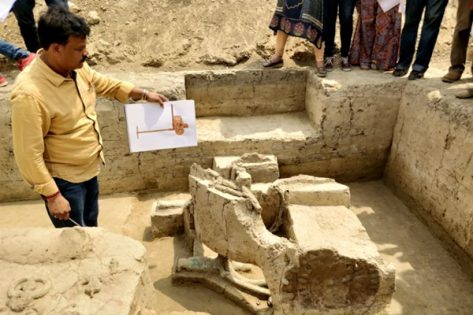
Sanauli Chariot; Source: news18.com
In the heart of Janardan Mountain near the Brahmaputra in North Guwahati in Assam stands the Aswakranta Temple that dates back to antiquity. The present temple structure was built during the reign of Darangi Raja, who ruled from 1604-1613. Hoofprints of horses on the large rocks below the temple are still a mystery. This temple finds mention in the Kalika Purana and Yogini Tantra. According to popular belief, these are hoofprints of the seven white aswas (horses) that Krishn rode from Dwarka to Pragjyotishpur to fight against the then king Narakasur. There are three more versions to the hoofprints story according to local folklore, all of which point that these were of horses of Krishna from the Mahabharata period.
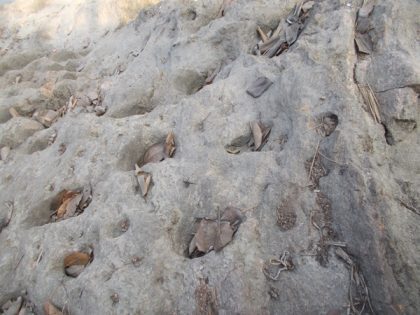
Hoofprints on the rock near Aswakranta temple, believed to be that of the horses of Krishna’s chariot
Besides the above, there are more literary and archaeological evidences that outrightly debunks the myth and the fake narrative create that horses are not indigenous to India. More excavations at different sites across India will lead to unearthing of more evidences.
The so called scholars and historians who have create the fake Aryan Migration/Invasion theory and spread a myth that horses were imported to India from foreign lands would not go beyond the Indus Valley site for research. In fact, their theory isn’t based on research but on assumptions. They will never move towards South too where there are evidences of rock art dating back to 8000 years in Edakkal caves, or the Jwalapuram site that led to discovery of artefacts dating back to 75000 years or Keeladi in Tamil Nadu that familiarises us with an advanced civilization dating back to 3500 years or Asurgarh Fort excavation site in Odisha where traces of advanced civilization dating back to 2,500-3500 years were found. And neither will they believe in the habitation that existed in the Saraswati river belt some thousands of years ago. Because focusing only on Indus valley will help them keep their theory alive and prove the antiquity of ancient Indian civilization centered around Indus valley only, dating back to very counted few thousands years.
Ref: Link to source references marked in bold/italics throughout the article.

